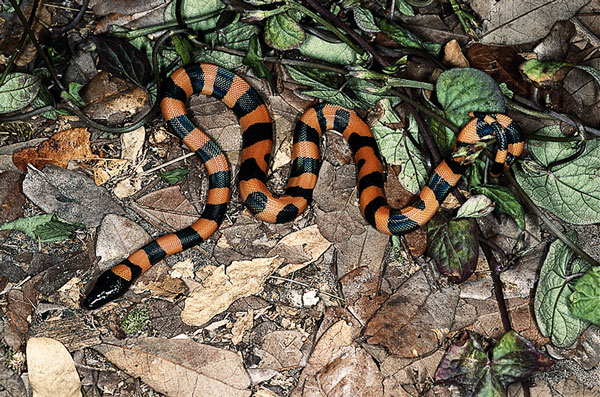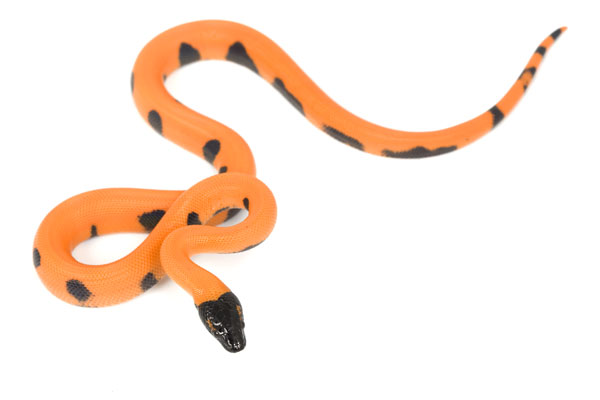Care sheet for the Bismarck ringed python (Bothrochilus boa)
Updated January 30, 2023
The Bismarck ringed python (Bothrochilus boa) is not a beginner species. It is a somewhat rare, exotic snake that is more suitable for the advanced reptile keeper due to its higher humidity requirements and very strong feeding response. With a dedicated keeper who prioritize reptile health and wellness, this species can thrive in captivity. It is a small- to medium-sized species that exhibits a beautiful iridescence; a juvenile ringed python is a bright orange and black, small, slender python that is so beautiful it almost appears to be artificial.

The exotic Bismarck ringed python is recommended for advanced snake keepers, not beginners. Photo credit: Bill Love
Ringed Python Availability
Bismarck ringed pythons are still relatively rare in collections and not often seen for sale. They can sometimes be found seasonally for sale on the internet or at larger reptile expos. It is always wise to buy directly from a breeder of captive-born ringed pythons to ensure quality and healthy hatchlings.
Captive-born ringed pythons are all that have been offered for sale for many years, which is good for the buyer because captive-born animals are healthier and always preferred over imported animals.
Ringed Python Size
Hatchling ringed pythons are about 7 to 9 inches long and as thick as a pencil. Adult ringed pythons typically reach lengths of 4 to 7 feet and can be as thick as a golf ball up to about the size of a racquet ball.
Ringed Python Life Span
It is believed that ringed pythons can live into their late 20s or longer, though information regarding the captive life span of this species is scarce.
Ringed Python Caging
Ringed python enclosures can vary, from commercially available reptile terrariums to large plastic tubs. I personally prefer plastic cages or tubs because these make it easier to control the high humidity requirements of ringed pythons.

Photo credit: fivespots/Shutterstock
Juvenile Bismarck ringed python.
Hatchling ringed pythons can be kept in small, shoebox-sized plastic containers. As the animals grow, so should the size of their enclosures. Adult ringed pythons can be housed comfortably in a cage measuring 4’x’2x’2′. The height of the cage is not as important as the floor space because these pythons are more terrestrial than arboreal. Ringed pythons can be shy, so snake habitat products such as a hide should always be available.
I do not recommend housing ringed pythons in glass fish tanks with screened lids, due to potential heat and humidity loss, and the unsecure, out-in-the-open feeling they may give this shy python.
Ringed Python Temperature and Humidity
Ringed pythons should be kept at temperatures ranging from 75 to 88 degrees Fahrenheit, with an elevated relative humidity of about 60 to 80 percent measure with a humidity hygrometer. Because ringed pythons have thinner skins than other pythons, a moist hide should always be available if the recommended elevated relative humidity cannot be achieved within the cage.
Snake Substrate
Proper cage bedding for ringed pythons includes paper towels or newspaper, mulch and commercially available reptile bedding materials. These can be found at local stores or reptile shops online. I prefer to stay away from dusty or very dry bedding, or any bedding that molds quickly in a high-humidity environment. It is important to keep the humidity high for ringed pythons, but you do not want them to be living on a wet cage substrate. Very wet cages can cause skin infections and bacteria growth within the substrate.
Ringed Python Food and Water
Hatchling ringed pythons are able to eat small pink mice as their first meals. It is best to try to buy hatchlings that are already feeding because some can be more difficult to get feeding and may need some experienced tease-feeding or scenting to get them to take their first meal. Once ringed pythons do start feeding, they have ravenous appetites and will seldom refuse a meal.
Hatchlings and immature snakes have a very high metabolism and will need to be fed frequently while growing. I feed my new hatchlings every three to four days while they are feeding on small mouse pinkies. Once they move up to mouse fuzzies they are fed every four to six days, and once they move up to rat pinks they are fed every five to seven days. Adults should be offered multiple small food items every 10 to 14 days, depending on the condition of the particular snake being fed and the amount of food offered.
Due to the ringed python’s small head size, it is always better to offer multiple smaller food items rather than one large meal. And because they are aggressive feeders, it is important not to overfeed ringed pythons, which can lead to obesity and health problems. Ringed pythons should always have a water bowl with fresh water available.
Ringed Python Handling and Temperament
As mentioned, the ringed python has a voracious feeding response, so it is always good to use a snake stick or other object—but not feeding tongs—to gently nudge them before removing them from an enclosure. This lets them know that it’s not feeding time and should prevent a strike (I recommend this practice for all pythons, not just ringed pythons).
Because ringed pythons are shy, can be startled easily, and are sometimes cage-defensive, I recommend using a snake hook to remove a ringed python from its cage. Once it is out and being handled, it will typically calm down quickly and will tolerate short handling sessions. Support as much of the python’s body as possible—this makes it feel secure—while allowing it to cruise freely through your hands. Do not grab it suddenly, make quick movements or restrain a ringed python, as this may scare it and lead to a defensive reaction.
Tom Keogan has kept ringed pythons for nearly 20 years and is one of the few people consistently breeding them in the U.S. for the past 15 years. Visit his website at blackheadedpython.com.


